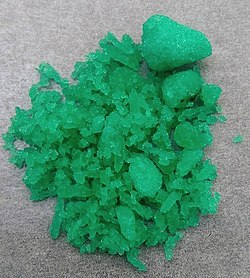Nickel(II) perchlorate is a collection of inorganic compounds with the chemical formula of Ni(ClO4)2(H2O)x. Its colors of these solids vary with the degree of hydration. For example, the hydrate forms cyan crystals, the pentahydrate forms green crystals, but the hexahydrate (Ni(ClO4)2·6H2O) forms blue crystals. Nickel(II) perchlorate hexahydrate is highly soluble in water and soluble in some polar organic solvents.[3]
 Some green nickel(II) perchlorate hexahydrate powder.
| |
| Names | |
|---|---|
| IUPAC name
Nickel(II) perchlorate
| |
| Other names
Nickel diperchlorate
Nickel perchlorate Nickel(II) chlorate(VII) Nickel diperchlorate(VII) Nickel perchlorate(VII) | |
| Identifiers | |
| |
3D model (JSmol)
|
|
| ChemSpider | |
| ECHA InfoCard | 100.033.735 |
| EC Number |
|
PubChem CID
|
|
CompTox Dashboard (EPA)
|
|
| |
| |
| Properties | |
| Cl2H12NiO14 | |
| Molar mass | 365.68 g·mol−1 |
| Density | 2.98 g/cm³ (hydrate)[1] 1,508 g/cm³ (hexahydrate) |
| Melting point | 140 °C (284 °F; 413 K) (hexahydrate) 149 °C (300 °F; 422 K) (partially decomposed pentahydrate) 103 °C (217 °F; 376 K)) |
| 259 g/100 mL (hexahydrate) | |
| Solubility | soluble in alcohol, aceton |
| Hazards | |
| Occupational safety and health (OHS/OSH): | |
Main hazards
|
oxidization |
| GHS labelling: | |
   
| |
| Danger | |
| H271, H314, H317, H334, H341, H350, H360, H372, H410 | |
| P201, P260, P273, P280, P303+P361+P353, P304+P340+P310, P305+P351+P338, P308+P313, P391[2] | |
| Flash point | flammable |
| Related compounds | |
Other anions
|
Nickel perrhenate Nickel nitrate |
Other cations
|
Iron(II) perchlorate Copper(II) perchlorate |
Except where otherwise noted, data are given for materials in their standard state (at 25 °C [77 °F], 100 kPa).
| |
Preparation
editAqueous solutions of nickel(II) perchlorate can be obtained by treating nickel(II) hydroxide, nickel(II) chloride or nickel(II) carbonate with perchloric acid.
- Ni(OH)2 + 2HClO4 + 4H2O → Ni(ClO4)2·6H2O
Two hydrates have been characterized by X-ray crystallography: the hexahydrate[4][5] and the octahydrate.[6] Several other hydrates are mentioned including the pentahydrate, which is claimed to crystallize at room temperature, the nonahydrate, which is claimed to crystallize at −21.3 °C, a tetrahydrate, and a monohydrate.[7]
The yellow anhydrous product is obtained by treating nickel(II) chloride with chlorine trioxide. As deduced by X-ray crystallography, Ni resides in a distorted octahedral environment and the perchlorate ligands bridge between the Ni(II) centers.[8]
Applications
editNickel(II) perchlorates has few practical uses.
Other compounds
edit- Ni(ClO4)2 also forms some compounds with NH3, such as Ni(ClO4)2·6NH3 which is a light purple crystal.[9]
- Ni(ClO4)2 also forms some compounds with N2H4, including Ni(ClO4)2·2N2H4 as a light positive solid or Ni(ClO4)2·5N2H4 which are purple crystals.[10]
- Ni(ClO4)2 forms compounds with CO(NH2)2, like Ni(ClO4)2·6CO(NH2)2 which is a yellow-green solid.[11]
- Ni(ClO4)2 forms compounds with CON3H5, for example Ni(ClO4)2·3CON3H5 which is a blue solid.[12]
- Ni(ClO4)2 forms compounds with CON4H6, such as Ni(ClO4)2·3CON4H6 which is an explosive blue crystal with a bulk density of 0.95 g/cm³.[13]
- Ni(ClO4)2 can also form compounds with CS(NH2)2, such as Ni(ClO4)2·6CS(NH2)2 which is a pale green solid.[14]
- Ni(ClO4)2 also forms some compounds with CSN3H5, such as Ni(ClO4)2·2CSN3H5·3H2O which is a blue paramagnetic crystal[15] or Ni(ClO4)2·3CSN3H5·2H2O which is a dark positive crystal.[16]
- Ni(ClO4)2 also forms some compounds with pyridine.[17]
Further reading
edit- D. Nicholls (2013), The Chemistry of Iron, Cobalt and Nickel Comprehensive Inorganic Chemistry, Elsevier, p. 1131, ISBN 978-1-4831-4643-0
See also
editReferences
edit- ^ Handbook… (Pierre Villars, Karin Cenzual, Roman Gladyshevskii; Walter de Gruyter GmbH & Co KG, 24 thg 7, 2017 - 1970 pages), page 442. Retrieved February 8, 2021.
- ^ Sigma-Aldrich Co., product no. {{{id}}}.
- ^ Daniela Sustac Roman, "Nickel (II) perchlorate hexahydrate", Encyclopedia of Reagents for Organic Synthesis, John Wiley & Sons, Ltd, doi:10.1002/047084289X.rn01550
- ^ Le Borgne, G.; Weigel, D. (1972). "Etude Thermogravimetrique et Structurale des Perchlorates de Nickel". Bulletin de la Societe Chimique de France: 3081-3085.
- ^ "Ni(ClO4)2·6H2O (Ni[ClO4]2[H2O]6 ht) Crystal Structure". Springer Materials. 2016-07-07.
- ^ Staples, R. J.; Hatfield, T. L.; Pierce, D. T. (1998). "Crystal Structure of Hexaaquanìckel(II) Perchlorate Dihydrate, [Ni(Н2O)б][СIO4]2 2Н2О". Zeitschrift für Kristallographie - New Crystal Structures. 213 (1–4): 257–258. doi:10.1524/ncrs.1998.213.14.257.
- ^ J. Newton Friend (1922). "Cobalt, Nickel, and the Elements of the Platinum Group". In J. Newton Friend (ed.). Textbook of Inorganic Chemistry (PDF). Vol. IX, part I. ISBN 978-1110346271.
- ^ Pascal, Jean-Louis; Favier, Frédéric (1998). "Inorganic Perchlorato Complexes". Coordination Chemistry Reviews. 178–180: 865–902. doi:10.1016/S0010-8545(98)00102-7.
- ^ A Text-book Of Inorganic Chemistry Vol-x, trang 192 – [1]. Retrieved April 1, 2020.
- ^ Maissen, Bernhard; Schwarzenbach, G. (1951). "Eine Substanz von äusserster Gefährlichkeit: Hydrazinnickelperchlorat". Helvetica Chimica Acta (in German). 34 (6): 2084–2085. doi:10.1002/hlca.19510340650.
- ^ Stonestreet, Beverly C.; Bull, William E.; Williams, Randall J. (1966). "Co-ordination compounds of 1,3-dimethylurea". Journal of Inorganic and Nuclear Chemistry. 28 (9): 1895–1900. doi:10.1016/0022-1902(66)80278-6.
- ^ Soviet Journal of Coordination Chemistry. 2 (2): 944. 1977 https://books.google.com/books?id=6bgdAQAAMAAJ.
{{cite journal}}: Missing or empty|title=(help) - ^ M. B. Talawar, A. P. Agrawal, J. S. Chhabra, S. N. Asthana – Studies on lead-free initiators: synthesis, characterization and performance evaluation of transition metal complexes of carbohydrazide. J. Hazard Mater., 113 (1–3), 57–65 (September 10, 2004). doi:10.1016/j.jhazmat.2004.07.001.
- ^ Complexes of some nickel(II) salts with thiourea – Juan Costamagna. Retrieved March 4, 2021.
- ^ Sirota, A., & Šramko, T. (1974). Square planar NiII complexes of thiosemicarbazide. Inorganica Chimica Acta 8, 289–291. doi:10.1016/s0020-1693(00)92630-6.
- ^ Chemické Zvesti, Tập 30,Trang 1-408 (1976), page 94. Retrieved March 10, 2021.
- ^ F. Madaule-Aubry, W. R. Busing, G. M. Brown: Crystal structures of complexes of nickel perchlorate with substituted pyridines. II. Tetrakis-(3,4-dimethylpyridine)nickel(II) perchlorate. In: Acta Crystallographica Section B: Structural Crystallography and Crystal Chemistry. 24, S. 754, doi:10.1107/S056774086800316X.